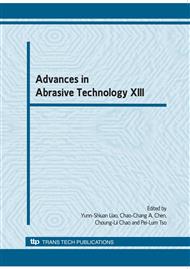p.407
p.415
p.423
p.429
p.435
p.441
p.447
p.457
p.463
Polyline Dwell Time Algorithm for Every Type of Tool Path for Ultrasonic-Magnetorheological Combined Finishing
Abstract:
Ultrasonic- magnetorheological combined finishing (UMC) is a new technique for the ultraprecision machining of aspheric surfaces, especially for high quality workpieces with small curvature radius concave surfaces. According to the characteristics of UMC finishing, material removal model has been developed. Several types of tool path planning algorithm have been discussed. Two kinds of polyline dwell time algorithm are presented. Polyline Dwell time algorithm based on two-dimensional discrete convolution is a new dwell time algorithm, and the dwell time on the endpoints which compose the tool path can be solved by the algorithm directly. Every polyline dwell time is the mean value of dwell time of two endpoints, therefore, the polyline dwell time of every type of tool path can be solved efficiently by the algorithm. The simulation of two dwell time algorithms has been conducted with same removal function and original error distribution, and the pv convergence rate is improved from 0.939 to 0.973 by using new algorithm. Figure error PV values reduced to 29.4 nm from 1.67μm after UMC finishing. The efficiency of the polyline dwell algorithm is proved by computer simulation and experimental results.
Info:
Periodical:
Pages:
435-440
Citation:
Online since:
August 2010
Authors:
Price:
Сopyright:
© 2010 Trans Tech Publications Ltd. All Rights Reserved
Share:
Citation:


